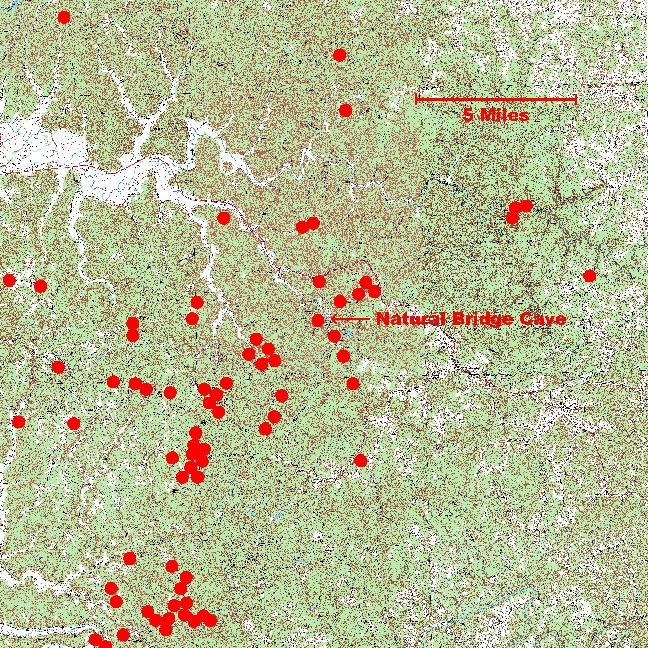 This is a map of the Natural Bridge State Park area. It was
produced for SaveOurCave by Tom Martin, who has explored this area for more
than forty years. The following is his description of the map:
This is a map of the Natural Bridge State Park area. It was
produced for SaveOurCave by Tom Martin, who has explored this area for more
than forty years. The following is his description of the map:
 This is a map of the Natural Bridge State Park area. It was
produced for SaveOurCave by Tom Martin, who has explored this area for more
than forty years. The following is his description of the map:
This is a map of the Natural Bridge State Park area. It was
produced for SaveOurCave by Tom Martin, who has explored this area for more
than forty years. The following is his description of the map:
"Each red dot indicates underground locations where bats might be found. The dots represent 67 limestone caves, 3 abandoned underground rock quarries, 1 abandoned mine, and 1 abandoned train tunnel (not the one at the Park). Sandstone tunnels have not been shown. Each dot represents places I have visited. Caves I vaguely remember, but can no longer locate, are not included. Caves I have been told about, but have not yet visited, are also not shown.
Within this area (and readily seen on full-resolution topographic maps) are huge numbers of sinks and cave openings which I have not yet been to. Also, in this part of Kentucky, most limestone caves are found in valleys. I have been in less than 1% of the valleys shown on this map, so I must assume that there remains a huge number of caves, perhaps hundreds, which I know nothing about.
In order to protect the endangered bats seen in many of these caves, my map was purposely designed to make the caves difficult to locate. This was accomplished by publishing the map at very low resolution, and making the red dots very large, covering an area of approximately 84 acres."
A Bit
About Bats
Bats are one of the most feared and misunderstood creatures on the planet. This is unfortunate because they are most unique creatures, and very important to the well-being of man. Some bat species are integral to the pollination of plants because of the pollen they transfer as they dine on flower nectar. Other species feed on insects which ravage our crops and carry diseases. Flying swiftly through the air, a bat can eat several thousand insects in a single night. Some have been known to consume half their body weight in one evening of such feasting.
Unfortunately, as much as we depend upon bats, we have historically been the major force in their destruction. Unlike many of God's creatures, many bat species have great difficulty adjusting to changing environments or unexpected pressures, and little is required to cause their demise. Merely entering where they hibernate can cause many to die.
Each time that a road is built through a forest or an insecticide is applied to the land, harm is likely done to the local bat populations because of destruction of their habitat or the poisoning of their food. One of the most sensitive of these species is the Virginia big-eared bat because its food is primarily moths and its shelter requirements are rigid.
Now, an even greater threat than man has arisen to plague these flying mammals: White nose syndrome. Thus far it has not been observed in Kentucky's bats, but like any contagious disease, it is spreading. Because it's not known if the disease can be transmitted to man, it is wise to keep people away from infected bats. This potential danger to humans, combined with the fact that a small percentage of Kentucky's bats are infected with rabies, makes it very imprudent to establish a bat colony next to the two most popular trails in Natural Bridge State Park.
To learn more about bats and how you can help protect them, check out these
additional links:
http://www.biology.eku.edu/bats/vabebatdist.htm
http://www.ksscaves.org/member_services/closed_cave_list.html
http://www.biology.eku.edu/bats/vabigearbat.htm
http://www.esasuccess.org/reports/profile_pages/VirginiaBigearedBat.html
http://www.wvdnr.gov/Wildlife/Magazine/Archive/03Summer/Shedding_Light.shtm http://www.wvu.edu/~agexten/wildlife/bats.pdf
http://www.natureconservatory.net/wherewework/northamerica/states/indiana/misc/art24537.html
http://www.washingtonpost.com/wp-dyn/content/article/2009/04/10/AR2009041003631.html
http://www.batcon.org/home/default.asp
http://www.npwrc.usgs.gov/resource/wildlife/recoprog/states/species/plectowv.htm
http://www.mnn.com/local-reports/kentucky/student-blog/kentuckys-most-endangered-species-bats
ttp://www.wvdnr.gov/wildlife/magazine/Archive/06fall/VaBEB.pdf